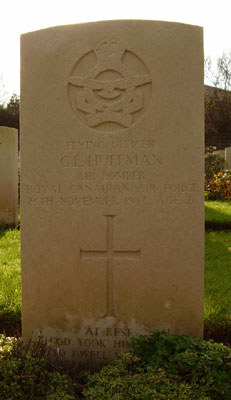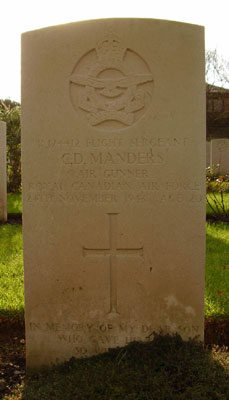Lancaster LL629 near High Mowthorpe, North Grimston.
Just after midnight of 24th November 1943 the crew of this 426 Squadron Lancaster were returning from a raid on Germany. This aircraft was one of 383 aircraft that had taken part with 365 of these aircraft being Lancasters. This aircraft was damaged by flak over Berlin knocking out the starboard outer engine and the aircraft's GEE navigation system. The aircraft limped back to the UK and because of the GEE being out of action it ended up way off track on the return flight. The crew requested a radio baring which brought them over the Yorkshire Coast at around 1000 feet. Shortly after this they requested another baring to get them to Linton on Ouse, this new baring however would route them in a direct heading with high ground of the Yorkshire Wolds. The Halifax flew into high ground at 00.30hrs near High Mowthorpe Farm, south-east of North Grimston, where it reportedly cartwheeled on impact and ended up on it's back. Two airmen were killed, four were injured and one remarkably escaped injury. The wireless operator was later Mentioned in Dispatches for his actions at the crash site, for "courage and presence of mind", he was directly responsible for the death toll in the crash not being higher having rescued a number of his crew himself. The pilot, navigator and mid upper gunner all received dead injuries, they were initially taken to a nearby searchlight site and then to a farmhouse near Duggleby (tel.23) The navigator was not the crew's regular navigator, this officer was 426 Squadron's Senior Navigation Officer and was coming to the end of his tour.
Lancaster LL629's history is brief; after being built to contract ACFT/239 by Armstrong Whitworth Ltd at Baginton, LL629 was taken on charge by 426 Squadron at Linton-on-Ouse on 7th November 1943. It was destroyed as a result of the accident at High Mowthorpe on 24th November 1943, Cat.E2/FB Burnt damage was the damage assessment and it was struck off charge on 1st December 1943.
Air Bomber - F/O George Lawrence Huffman RCAF (J/21575), aged 26, of Winnipeg, Manitoba, Canada. Buried Harrogate Stonefall Cemetery, Yorkshire (C/E/7).
Rear Gunner - F/Sgt Clarence Delrose Manders RCAF (R/124412), aged 20, of West Kildonan, Winnipeg, Manitoba, Canada. Buried Harrogate Stonefall Cemetery, Yorkshire (C/E/8).
Those who survived were..
Pilot - F/O David R DeBloeme RCAF (J/17502), of Windsor, Ontario, Canada. Injured.
Flight Engineer - Sgt Frederick Cameron Borst RAFVR (1449946), of Southampton, Hampshire. Injured.
Navigator - F/Lt James Barry Cleveland RCAF (J/15084), of Toronto, Ontario, Canada. Seriously injured.
Wireless Operator / Air Gunner - Sgt William Henry McGarrighan RAFVR (1451464), of Rawtenstall, Lancashire. Slightly injured.
Mid Upper Gunner - F/Sgt Willard Graham Martin RCAF (R/75406), of Westville, Nova Scotia, Canada. Seriously injured.
George Huffman was born on 10th April 1917 in Winnipeg, Manitoba, Canada and was the son of George Edwin and Ann Eliza (nee Moore) Huffman. His father died in 1927.
As a young man he left school in 1933 and began working for as a general labourer but in 1936 started work in the Central Patricia Gold Mine in Ontario and worked there until 1941.
He enlisted for RCAF service on 24th March 1942 in Winnipeg and trained as an air bomber, gaining his air bomber's badge on 4th December 1942 and a commission on the same date. On arrival in the UK he would train at 23 OTU before posting to 426 Squadron on 10th June 1943 who were still flying Wellingtons. He was later posted on detachment to 1679 Conversion Flight in July 1943 to convert to the Lancaster type before posting back to 426 Squadron.
Clarence Manders was born on 29th August 1923 in Winnipeg, Manitoba and was the son of Herbert and Maude (nee Young) Manders. His father died when he was young. Clarence had just left school in 1941 and had been working as a clerk for a company in Winnipeg for only a few months when he enlisted for RCAF service in Winnipeg on 4th September 1941. Following training in Canada he was awarded his Air Gunner's badge on 30th December 1942. On arrival in the UK he trained at 7 AGS and 23 OTU before posting to 426 Squadron on 10th June 1943. 426 Squadron soon converted from flying Wellingtons to Lancasters so he and his crew were posted to 1679 Conversion Flight to convert to fly the Lancaster type in July 1943 before returning to 426 Squadron.



As stated above Sgt William McGarrighan was awarded a Mention in Despatches for his actions after the crash, this originated as a recommendation for the B.E.M. The MiD was printed in the London Gazette on 8th June 1944 but the recommendation reads.. "This airman was Wireless Operator in a Lancaster aircraft which crashed in the darkness at an isolated locality on return from a raid on Berlin on the night of 23rd/24th November 1943, killing two members and severely injuring three other members of the crew. Although he escaped with only slight injuries, he later had to be treated for shock; nevertheless, Sergeant McGarrighan displayed remarkable self-control at the scene of the crash. With complete disregard for personal safety he climbed through burning wreckage and assisted two of his injured comrades to safety. He then set out to summon help and gave no thought to his own injuries until he was assured that ambulances had arrived for his injured crew mates, and until he had contacted Base and given a report of the accident. I feel that such remarkable courage and presence of mind should be duly recognized and recommend the award of the British Empire Medal." He was born in the Haslingden area of Lancashire in 1910 and married in the same district in 1932 and died at a reasonably young age in the same district in 1969.
Before this incident, David DeBloeme had completed eight operational flights. He returned home to Canada after the War and died in May 2003; he was a former president of the Prince Edward Branch of the Canadian Legion.
In Peter Clark's poorly researched book "An Unexpected Foe" he names one Sgt George Martin RCAF (R/163413) as dying of injuries on 31st January 1944 as a result of this incident to Lancaster LL629 near North Grimston. Sgt George Martin RCAF (R/163413) was infact killed as a result of the crash of Halifax DK185 on Ilkley Moor. I find it bizarre that such an error can be made in the age of the internet before his book went to print. It's a shame that this book was so poor when his others were so good.